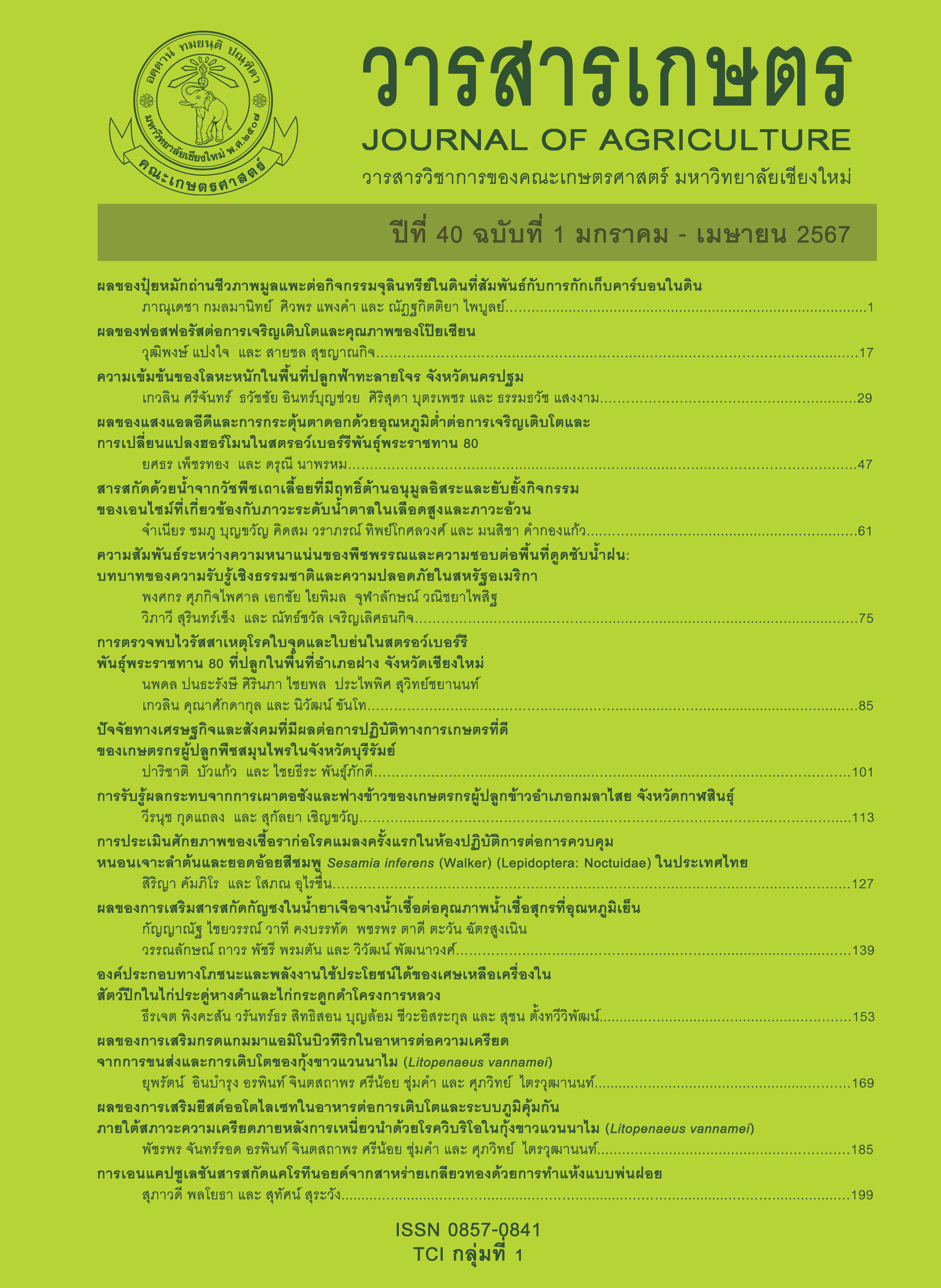ผลของแสงแอลอีดีและการกระตุ้นตาดอกด้วยอุณหภูมิต่ำต่อการเจริญเติบโตและการเปลี่ยนแปลงฮอร์โมนในสตรอว์เบอร์รีพันธุ์พระราชทาน 80
Main Article Content
บทคัดย่อ
ปัจจุบันระบบโรงงานผลิตพืชภายใต้แสงแอลอีดีได้ถูกนำมาใช้ในการปลูกสตรอว์เบอร์รี เนื่องจากประสบปัญหาความแปรปรวนของภูมิอากาศ ซึ่งทำให้ผลผลิตของต้นสตรอว์เบอร์รีลดลง ดังนั้น การศึกษาครั้งนี้จึงมีจุดประสงค์เพื่อศึกษาผลของระยะเวลาให้แสงแอลอีดีและการกระตุ้นตาดอกด้วยอุณหภูมิต่ำต่อการเจริญเติบโตและการเปลี่ยนแปลงฮอร์โมนในสตรอว์เบอร์รีพันธุ์พระราชทาน 80 โดยแบ่งเป็น 2 การทดลอง คือ การทดลองที่ 1 ผลของระยะเวลาให้แสงแอลอีดีต่อการผลิตไหลของสตรอว์เบอร์รี วางแผนการทดลองแบบสุ่มสมบูรณ์ จำนวน 5 กรรมวิธี คือ แสงจากสภาพแวดล้อมธรรมชาติ (กรรมวิธีควบคุม) และการให้แอลอีดีที่จำนวนชั่วโมงต่างกัน 4 กรรมวิธี (9, 12, 15 และ 18 ชั่วโมงต่อวัน) พบว่า ทุกระยะเวลาการให้แสงแอลอีดีไม่มีผลต่อระยะเวลาเกิดไหล และความกว้างใบ แต่กรรมวิธีที่ให้แสงแอลอีดี 15 และ 18 ชั่วโมง ทำให้จำนวนเส้นไหล ต้นไหล ก้านใบ และค่าคลอโรฟิลล์ในใบสูงกว่าทุกกรรมวิธีอย่างมีนัยสำคัญทางสถิติ ในขณะเดียวกันการให้แสงแอลอีดี 9 ชั่วโมง ทำให้ต้นไหลมีความสูงมากที่สุด ส่วนการทดลองที่ 2 ผลของระยะเวลาให้แสงแอลอีดีและการชักนำตาดอกด้วยอุณหภูมิต่ำต่อการออกดอกและการเปลี่ยนแปลงฮอร์โมนของสตรอว์เบอร์รี วางแผนการทดลองแบบแฟคทอเรียลในสุ่มสมบูรณ์ คือ ระยะเวลาให้แสงแอลอีดี 3 วิธี (6, 9 และ 12 ชั่วโมงต่อวัน) และการให้สภาพอุณหภูมิต่างกัน 2 วิธี (ไม่กระตุ้นตาดอกด้วยอุณหภูมิต่ำ และกระตุ้นตาดอกด้วยอุณหภูมิต่ำ 4 องศาเซลเซียส เป็นเวลา 2 สัปดาห์) เปรียบเทียบกับสภาพแวดล้อมธรรมชาติ (กรรมวิธีควบคุม) ผลการทดลองพบว่าทั้งสองปัจจัยไม่มีปฏิสัมพันธ์กัน กรรมวิธีที่ให้แสงแอลอีดี 9 ชั่วโมง และการกระตุ้นด้วยอุณหภูมิต่ำ ทำให้ต้นสตรอว์เบอร์รีออกดอกเร็ว และมีจำนวนดอกมากกว่าทุกกรรมวิธีอย่างมีนัยสำคัญทางสถิติ โดยกรรมวิธีดังกล่าวลดการสังเคราะห์และสะสมออกซิน (IAA) ในขณะที่ส่งเสริมการสร้างและสะสมไซโตไค-นิน (zeatin และ zeatin riboside) ซึ่งสามารถชักนำการออกดอกและการพัฒนาดอกของต้นสตรอว์เบอร์รีได้
Article Details

อนุญาตภายใต้เงื่อนไข Creative Commons Attribution-NonCommercial-NoDerivatives 4.0 International License.
เอกสารอ้างอิง
Agar, G., M. Turker, P. Battal and M.E. Erez. 2006. Phytohormone levels in germinating seeds of Zea mays L. exposed to selenium and aflatoxins. Ecotoxicology 15(5): 443-450.
Boonyakiat, D. 2020. Plant Physiology. Faculty of Agriculture, Chiang Mai University, Chiang Mai. 292 p. (in Thai)
Boonyakiat, D. and P. Smitamana. 2003. Strawberry. Final Report. National Science and Technology Development Agency, Bangkok. 48 p. (in Thai)
Bradford, E., J.F. Hancock and R.M. Warner. 2010. Interactions of temperature and photoperiod determine expression of repeat flowering in strawberry. Journal of the American Society for Horticultural Science 135(2): 102-107.
Butare, D. 2020. Effect of temperature on plant growth and yield in ever-bearing strawberry Fragaria x ananassa, cv. Florentina. M.S. Thesis. Swedish University of Agricultural Sciences, Uppsala. 34 p.
Campos-Rivero, G., P. Osorio-Montalvo, R. Sánchez-Borges, R. Us-Camas, F. Duarte-Aké and C. De-la-Peña. 2017. Plant hormone signaling in flowering: An epigenetic point of view. Journal of Plant Physiology 214: 16-27.
Choi, H.G., B.Y. Moon and N.J. Kang. 2015. Effects of LED light on the production of strawberry during cultivation in a plastic greenhouse and in a growth chamber. Scientia Horticulturae 189: 22-31.
Durner, E.F. 2015. Photoperiod affects floral ontogeny in strawberry (Fragaria × ananassa Duch.) plug plants. Scientia Horticulturae 194: 154-159.
Fan, X., J. Zang, Z. Xu, S. Guo, X. Jiao, X. Liu and Y. Gao. 2013. Effects of different light quality on growth, chlorophyll concentration and chlorophyll biosynthesis precursors of non-heading Chinese cabbage (Brassica campestris L.). Acta Physiologiae Plantarum 35(9): 2721-2726.
Gallace, N. and P. Lieten. 2021. Winter manipulation of photoperiod and chill to enhance the perpetual flowering nature of ‘Soprano’. Acta Horticulturae 1309: 333-340.
Guttridge, C.G. 1959. Evidence for a flower inhibitor and vegetative growth promoter in the strawberry. Annals of Botany 23(90): 351-360.
Hanke, M.V., H. Flachowsky, A. Peil and C. Hattasch. 2007. No flower no fruit-Genetic potentials to trigger flowering in fruit trees. Genes, Genomes and Genomics 1(1): 1-20.
Hegele,M., D. Naphrom, P. Manochai, A. Chattrakul, P. Sruamsiri and F. Bangerth. 2004. Effect of leaf age on the response of flower induction and related hormonal changes in longan trees after KClO3 treatment. Acta Horticulturae 653: 41-49.
Hung, C.D., C.-H. Hong, H.-B. Jung, S.-K. Kim, N.V. Ket, M.-W. Nam, D.-H. Choi and H.-I. Lee. 2015. Growth and morphogenesis of encapsulated strawberry shoot tips under mixed LEDs. Scientia Horticulturae 194: 194-200.
Ikram, S., K.M. Qureshi and N. Khalid. 2016. Flowering and fruiting responses of strawberry to growth hormone and chilling grown under tunnel conditions. Pakistan Journal of Agricultural Sciences 53(4): 911-916.
Kang, J., Y. Lee, H. Sakakibara and E. Martinoia. 2017. Opinion cytokinin transporters: Go and stop in signaling. Trends in Plant Science 22(6): 455-461.
Ledesma, N.A., M. Nakata and N. Sugiyama. 2008. Effect of high temperature stress on the reproductive growth of strawberry cvs. ‘Nyoho’ and ‘Toyonoka’. Scientia Horticulturae 116: 186-193.
National Science and Technology Development Agency. 2018. Plant factory. (Online). Available: https://www.nstda.or.th/home/performance_post/plant-factory (March 15, 2022). (in Thai)
Pipattanawong, N. 2000. Strawberry: New Economic Crops. Kasetsart University Press, Bangkok. 158 p. (in Thai)
Pipattanawong, N., W. Tacha, B. Thongyean and S. Tiwong. 2011. Strawberry cv. Pharachatan 80. Kasetsart Extension Journal 56(1): 22-28. (in Thai)
Potchanasin, P., K. Sringarm, P. Sruamsiri and K.F. Bangerth. 2009. Floral induction (FI) in longan (Dimocarpus longan, Lour.) trees: Part I. Low temperature and potassium chlorate effects on FI and hormonal changes exerted in terminal buds and sub-apical tissue. Scientia Horticulturae 122: 288-294.
Rivero, R., S.F. Remberg, O.M. Heide and A. Sønsteby. 2021. Environmental regulation of dormancy, flowering and runnering in two genetically distant everbearing strawberry cultivars. Scientia Horticulturae 290: 110515, doi: 10.1016/j.scienta.2021.110515.
Samuoliené, G., A. Brazaityté, A. UrbonavičiÛté, G. Šabajeviené and P. Duchovskis. 2010. The effect of red and blue light component
on the growth and development of frigo strawberries. Zemdirbyste-Agriculture 97(2): 99-104.
Senger, H. 1982. The effect of blue light on plants and microorganisms. Photochemistry and Photobiology 35(6): 911-920.
Shen, J., Q. Xiao, H. Qiu, C. Chen and H. Chen. 2016. Integrative effect of drought and low temperature on litchi (Litchi chinensis Sonn.) floral initiation revealed by dynamic genome-wide transcriptome analysis. Scientific Reports 6: 32005, doi: 10.1038/srep32005.
Sønsteby, A., K.A. Solhaug and O.M. Heide. 2016. Functional growth analysis of ‘Sonata’ strawberry plants grown under controlled temperature and daylength conditions. Scientia Horticulturae 211: 26-33.
Sønsteby, A., T.L. Woznicki and O.M. Heide. 2021. Effects of runner removal and partial defoliation on the growth and yield performance of ‘Favori’ everbearing strawberry plants. Horticulturae 7(8): 215, doi: 10.3390/horticulturae7080215.
Sringarm, K., P. Potchanasin, D. Naphrom and K.F. Bangerth. 2009. Floral induction (FI) in longan (Dimocrapus longan, Lour.) trees – The possible participation of endogenous hormones: II. Low temperature and potassium chlorate effects on hormone concentrations in and their export out of leaves. Scientia Horticulturae 122: 295-300.
Susawaengsup, C., M. Rayanakorn, S. Wongpornchai and S. Wangkarn. 2011. Investigation of plant hormone level changes in shoot tips of longan (Dimocarpus longan Lour.) treated with potassium chlorate by liquid chromatography-electrospray ionization mass spectrometry. Talanta 85(2): 897-905.


